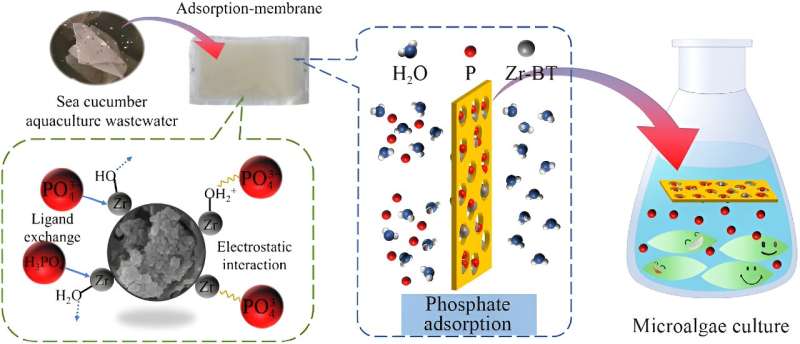This article has been reviewed according to Science X's editorial process and policies. Editors have highlighted the following attributes while ensuring the content's credibility:
fact-checked
proofread
Highly efficient method for removal of phosphate from aquaculture wastewater

Enhanced phosphorus treatment and recovery has been continuously pursued due to the stringent wastewater discharge regulations and a phosphate supply shortage. A team of researchers from Hohai University has now developed a new adsorption-membrane separation strategy for rational reutilization of phosphate from sea cucumber aquaculture wastewater using a Zr-modified-bentonite filled polyvinyl chloride membrane.
The obtained polyvinyl chloride/Zr-modified-bentonite membrane was highly permeable (940 L/(m2·h))—one to two times higher than those reported in other studies, and its adsorption capacity was high (20.6 mg/g) when the phosphate concentration in water was low (5 mg/L).
Their analysis was published in the journal Frontiers of Environmental Science & Engineering on October 20, 2023.
The problems associated with the development of intensive mariculture and the expansion of the scale of mariculture have become more diversified and complex in recent years. In China, the annual discharge of marine aquaculture wastewater even exceeds the discharge of land-based sewage flowing into the ocean.
It is believed that phosphorus is the primary source of eutrophication and its limiting factor because it cannot be fixed from the atmosphere like nitrogen. Phosphorus is also an important non-renewable resource and an important nutrient for the proper functioning of all living organisms. It is a crucial nutrient in agricultural products and could become depleted within 50 to 100 years given current trends. High levels of phosphorus might also be hazardous to the aquatic environment.
Recent research has shown that eutrophic seawater can turn into phosphate rock; hence, sustainable phosphorus recovery techniques should be used in marine systems to meet the growing demand for phosphorus while preventing eutrophication. Therefore, the advanced treatment of mariculture wastewater could be used to combat eutrophication in water bodies and alleviate the shortage of phosphorus resources.
Biological treatment is an inexpensive and environmentally friendly procedure, but it is inhibited by the high salinity and C/N/P ratio of mariculture wastewater. Chemical precipitation is often used because of its economic benefits, but it produces a large amount of sludge, which requires further treatment. Adsorption is considered superior to the above methods because of its operational flexibility and high efficiency for low phosphate concentrations.
Bentonite (BT) is a relatively cheap clay, and its utility for phosphate removal has been studied for many years. Lanthanum-modified bentonite (LMB), which is commercially known as Phoslock, has been tested in a laboratory and a lake. Compared with La, Zr is more abundant and has a higher affinity for phosphate (higher pKsp value). This is because Zr has strong Lewis acid properties and often forms internal spherical complexes through Lewis acid–base interactions. Thus, compared with Phoslock, Zr-modified-bentonite (Zr-BT) is a lower-cost alternative with higher phosphate adsorption capacity and selectivity.
However, the recovery of powdered adsorbents is often difficult. Membrane separation is a powerful technology for achieving ultra-low phosphorus concentrations, but the lower water flux affects the application of membrane adsorption in practical wastewater treatment. The cooperation of membrane technology and adsorbent provides a potential solution to this problem.
The adsorbent can be immobilized by the membrane material, and the membrane pore size increases following adsorbent doping, which increases water flux. Previous studies have achieved efficient phosphate adsorption when phosphate concentrations are high (> 50 mg/L). However, environmental requirements have become increasingly stringent; there is thus a need for studies to develop techniques that are effective when phosphate concentrations are low. The work of Professor Jianfeng Zhang's team fills this gap.
In this study, the research team evaluated the phosphate adsorption performance of polyvinyl chloride (PVC)/Zr-BT in wastewater with a low initial phosphate concentration (1 mg/L). They synthesized a novel Zr-modified bentonite-filled polyvinyl chloride membrane (PVC/Zr-BT) via situ crosslinking and the phase inversion method.
To determine the optimal preparation conditions, they conducted tests with membranes varying in thickness and adsorbent content. Additionally, the effects of different environmental factors, including initial pH, filtration time, initial concentration and competing ions on the efficiency of phosphate removal were investigated. The applicability of PVC/Zr-BT for phosphate removal from real water was also evaluated. The growth of Phaeodactylum tricornutum FACHB-863 was also investigated in the presence of the phosphate-adsorbed PVC/Zr-BT recovered from SCAW.
PVC/Zr-BT membrane with high adsorption capacity for phosphate in low-concentration phosphate solutions and high-salinity SCAW was made using a simple phase inversion method. When this membrane was used to treat low-concentration (1 mg/L) phosphate wastewater, the removal rate reached 98.5%, and this high removal rate was mainly related to ligand exchange and electrostatic interactions.
When the Cl− ion concentration was 50 mmol/L, the adsorption efficiency of phosphate by the membrane was as high as 92.6%. The highest amount of phosphate adsorbed by the membrane was 20.6 mg/g at an initial phosphate concentration of 5 mg/L. Phosphorus adsorbed by the membrane can be slowly desorbed for microalgal culture. Phaeodactylum tricornutum cultured for 16 days under these conditions had a biomass of 0.24 g/L and lipid content of 22.8%, which were comparable to that in a conventional f/2 culture medium.
The results of this study will aid the use of PVC/Zr-BT membrane for the recovery and reutilization of phosphates in SCAW when they are present at low concentrations. The findings indicate that this new membrane could be used for the purification of real wastewater systems as well as phosphorus reutilization.
More information: Aihua Zhang et al, Highly efficient and selective removal of phosphate from wastewater of sea cucumber aquaculture for microalgae culture using a new adsorption-membrane separation-coordinated strategy, Frontiers of Environmental Science & Engineering (2023). DOI: 10.1007/s11783-023-1720-2

















